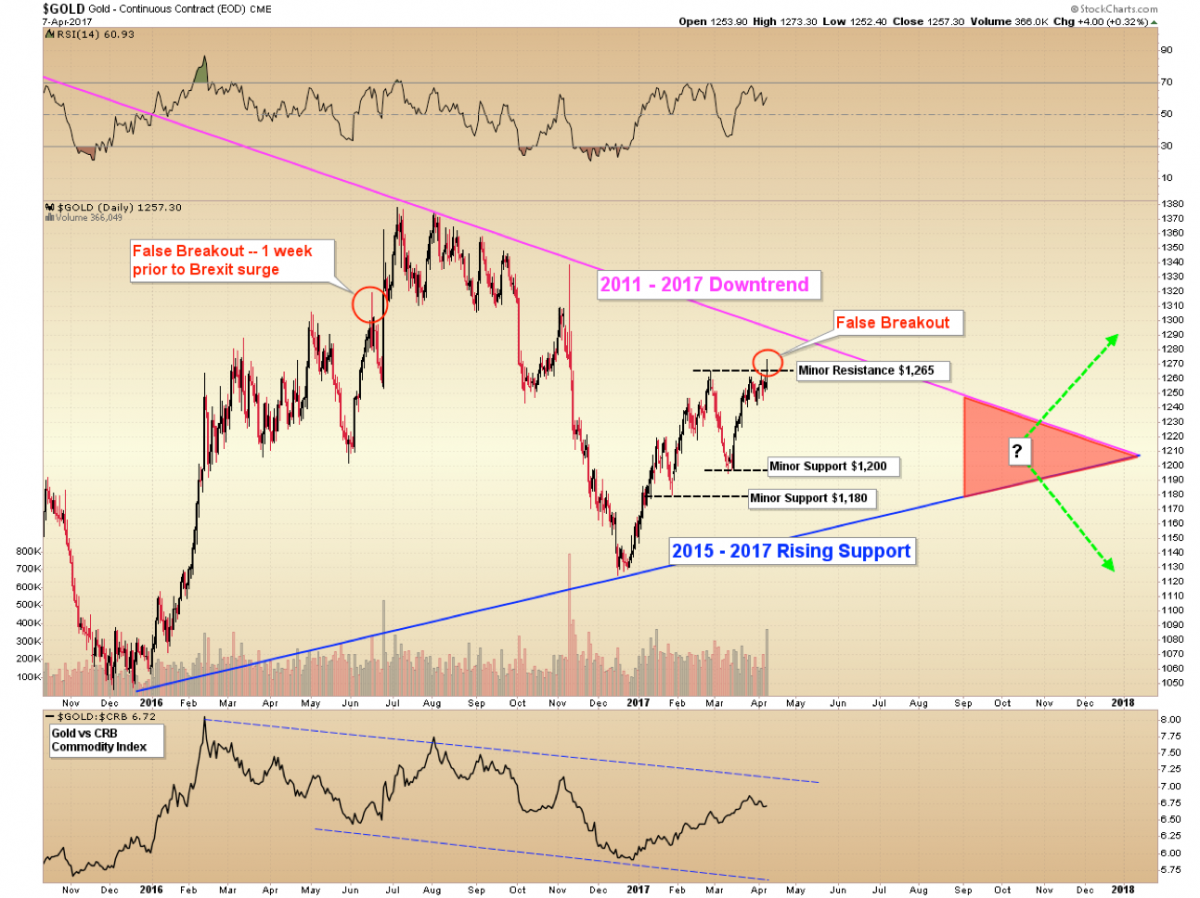Gold’s False Breakout – Continued Weakness To Come?
The surge above $1,265 for gold in the wake of the US retaliation against Syria, yet its failure to hold this level by Friday’s close, constitutes a “false breakout” in our technical work. False breakouts occur when an important resistance level is breached momentarily, but then buyers nearly disappear and new sellers show up, causing a reversal bar on the daily price chart.
False breakouts (or their inverse false breakdowns) tend to mark at least short-term reversals. However, the degree and length of the reversal cannot be determined simply from the single day of price action. It would be a mistake to think that all false breakouts portend major trend reversals. Perspective is key.
False breakouts which occur after multi-year advances tend to be ominous signals of major long-term tops. However, the gold market is not at the end of a multi-year advance. Rather, gold is 16 months removed from a multi-year bottom, and currently within the midst of a converging consolidation.
False breakouts which occur at a minor resistance level within a larger consolidation – which is what we have been labeling the $1,265 zone since March – simply indicate that a market needs to consolidate for some time further before it can sustain a stronger advance.
In this case, we expect gold to now retreat for some weeks or months further within the support zone. There is minor support at $1,240 (not labeled on the chart) and further minor support at $1,200 and $1,180. For gold to find support at any of these targets indicates continued healthy consolidative behavior.
Previous False Breakouts In Gold
A comparative example can be seen in the attempt to break through $1,300, which occurred one week prior to the Brexit vote last June. This is shown by the red callout on the chart above.
Note how the gold price spiked intraday above $1,300, only to reverse lower by the end of the day. This failed breakout attempt did indeed result in short-term weakness to the tune of a $50 decline over the following week. However, one week later on the Brexit vote, gold buying quickly surpassed this level on the $110 spike seen June 24.
The point is: short-term reversals do not equate to long-term tops.
Monitoring Gold’s Consolidation
We continue to believe that the consolidation underway is serving to wash out the last of the “hot money” that became interested in chasing the momentum of mid-2016. When the last of this hot money has exited, sufficient selling will have taken place to ensure that the next wave of interest causes a breakout of the converging pennant formation, labeled above in red.
The critical breakout we are anticipating by Q3 – Q4 of this year in gold, defined by the falling 2011 – 2017 downtrend (magenta) and the rising 2015 – 2017 support (blue) is now defined by the following levels:
Upper boundary: $1,285 - $1,290 and falling.
Lower boundary: $1,150 - $1,155 and rising.
For now, we expect continued basing action in the precious metals within the converging consolidation.
Summary
The reversal seen on Friday simply means that gold is due for more consolidation over the short run. This consolidation must resolve itself in one way or another within the next six months. The subsequent breakout should feature a price movement of at least $200 - $300 when it occurs. Stay tuned as we monitor leading indicators which should give us hints of the resolution ahead of time: the gold to silver ratio, the Japanese yen to US dollar cross-pair, and the relative strength of the gold mining complex being of primary importance.
********



















